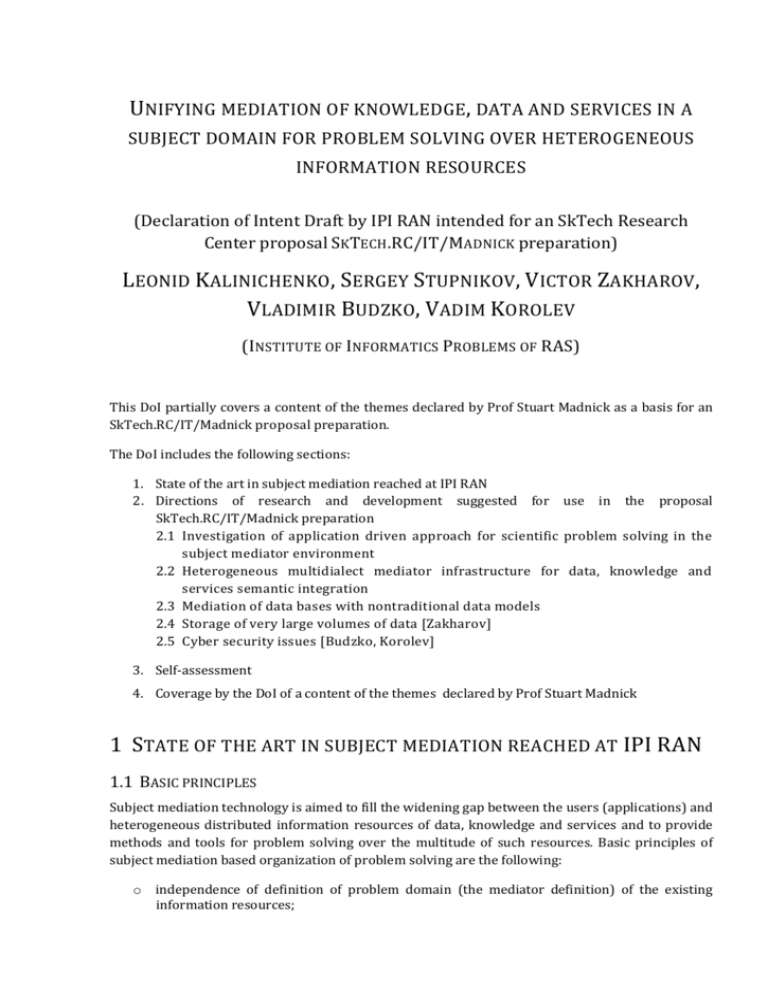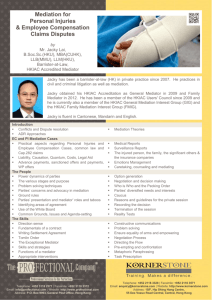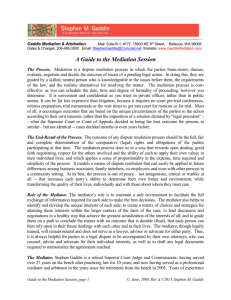SkTech-IPIRAN-intent..
advertisement

UNIFYING MEDIATION OF KNOWLEDGE, DATA AND SERVICES IN A SUBJECT DOMAIN FOR PROBLEM SOLVING OVER HETEROGENEOUS INFORMATION RESOURCES (Declaration of Intent Draft by IPI RAN intended for an SkTech Research Center proposal SKTECH.RC/IT/MADNICK preparation) LEONID KALINICHENKO, SERGEY STUPNIKOV, VICTOR ZAKHAROV, VLADIMIR BUDZKO, VADIM KOROLEV (INSTITUTE OF INFORMATICS PROBLEMS OF RAS) This DoI partially covers a content of the themes declared by Prof Stuart Madnick as a basis for an SkTech.RC/IT/Madnick proposal preparation. The DoI includes the following sections: 1. State of the art in subject mediation reached at IPI RAN 2. Directions of research and development suggested for use in the proposal SkTech.RC/IT/Madnick preparation 2.1 Investigation of application driven approach for scientific problem solving in the subject mediator environment 2.2 Heterogeneous multidialect mediator infrastructure for data, knowledge and services semantic integration 2.3 Mediation of data bases with nontraditional data models 2.4 Storage of very large volumes of data [Zakharov] 2.5 Cyber security issues [Budzko, Korolev] 3. Self-assessment 4. Coverage by the DoI of a content of the themes declared by Prof Stuart Madnick 1 STATE OF THE ART IN SUBJECT MEDIATION REACHED AT IPI RAN 1.1 BASIC PRINCIPLES Subject mediation technology is aimed to fill the widening gap between the users (applications) and heterogeneous distributed information resources of data, knowledge and services and to provide methods and tools for problem solving over the multitude of such resources. Basic principles of subject mediation based organization of problem solving are the following: o independence of definition of problem domain (the mediator definition) of the existing information resources; o o o o o o definition of a mediator as a result of consolidated efforts of the respective scientific community; independence of user interfaces of the multiple information resources involved: the mediator users should know only the definition of a problem domain in the mediator (definition of concepts, structures and behavior of the problem domain objects); information about new resources can be published at any time independently of mediators acting at that time, such new resources (if relevant) can be integrated in the existing mediators without changing their (mediators) specifications; GLAV-based setting for relevant information resources integration at the mediator; integrated access to the information resources in process of problem solving; recursive structure of a mediator: each mediator is published as a new information resource that might be used while solving the problems belonging to the intersection of various subject domains. 1.2 CANONICAL INFORMATION MODEL SYNTHESIS To provide an integration of heterogeneous resources in the mediators it is required to develop the canonical information model serving for adequate reflection of semantics of various information models used in the environment. The main principle of the canonical model synthesis is the extensibility of the canonical model kernel. A kernel itself is fixed. For each specific information model M (called source model) of the environment an extension of the kernel (target model) is defined so that this extension together with the kernel is refined by M. Such refining transformation of models should be provably correct. The canonical model for the environment is synthesized as the union of extensions, constructed for all models M of the environment. 1.3 RESOURCES IDENTIFICATION AND INTEGRATION Identification of resources relevant to the mediator specification is based on three models: metadata model (characterizing resource capabilities represented in external registries), ontological model (providing for definition of mediator concepts), and canonical model (providing for conceptual definition of structure and behavior of mediator objects). Reasoning in canonical model is based on the semantics of the canonical model and facilities for proof of the refinement. Reasoning in the metadata model is a heuristic one based on nonfunctional requirements for the resources needed in application. A process of integration of relevant information resources in a subject mediator (registration) follows GLAV that combines two approaches - Local As View (LAV) and Global As View (GAV). According to LAV the schemas of resources being registered in mediator are considered as materialized views over virtual classes of a mediator. GAV views provide for reconciliation of various conflicts between resource and mediator specifications as well as provide rules for transformation of results obtained from a resource into the mediator representation. Such registration technique provides for stability of application problem specification during any modifications of specific information resources and of their actual presence as well as for scalability of mediators w.r.t. the number of resources integrated. 1.4 SUBJECT MEDIATION INFRASTRUCTURE The subject mediation infrastructure is multilayered including resource layer, computation and information resource environments (that can include grids or clouds), wrapper layer used for technical interface interoperability, semantic mediation middleware layer representing subject area semantics and defining unified mappings of various resource information models, application problem domain layer (Fig. 1). Rule-based Rule-based Rule-based Programs Programs Programs Application Conceptualization Canonical Information Model (SYNTHESIS Language) Application Problem Domain W3C-RIF Broker Rule-based Mediator Programs Conventional Application Programs Mediator Specifications Semantic Mappings Service Wrapper Registry Wrapper Semantic Mediation Middleware Resource Wrappers Data Source Wrapper Computation and Information Resource Environments Resource Resource Resource Registry Registry Registry GridService Service Grid Grid Service Programming Facilities Resource Resource GridService Service Resource Registry Grid Grid Service Registry Grid Service Registry Grid Grid Service Service Information Grid Computational Grid Resource Resource Resource Registry Registry Registry Clouds Cloud Service Cloud Service Cloud Service Cloud Service Серверы Серверы Рабочие станции Серверы Большие ЭВМ Рабочие станции Серверы DataBases Figure 1. Subject mediation infrastructure 1.5 RESULTS OBTAINED AT IPI RAN IN THE AREA OF SEMANTIC INFORMATION INTEGRATION AND MEDIATION o A prototype of the subject mediation infrastructure has been developed. The prototype is used for problem solving over multiple distributed information resources in astronomy problem domain. One of the possible environments for resource organization used is the AstroGrid environment. o Methods and tools for mapping and transformation of information models of heterogeneous resources intended for their unification in mediation middleware have been developed. A resource model is said to be unified if its refining mapping into the canonical information model has been constructed. As a canonical model kernel a specific hybrid semi-structured and object oriented data model (the SYNTHESIS language) is used. Model mappings are verified using B-technology formalizing specification refinement. The Model Unifier prototype tool aimed at partial automation of heterogeneous information models unification has been implemented. First version is based on term-rewriting technology. The second version as an Eclipse platform application based on model transformation languages is under implementation. o Methods for information resources semantic interoperability support in a context of application problem domain have been investigated. Tools for identification of resources relevant to a problem on the basis of and ontological descriptions of problem domain as well as tools for registration of the relevant resources in the mediator have been implemented. o Methods and tools for rewriting of non-recursive mediator programs into resource partial programs have been developed. The methods are oriented on applying of object schemas of resources and mediators and typed GLAV-views. o A method for optimizing planning of resource partial programs execution over distributed environment has been developed. The method takes into account capabilities of the resources, assigns places of operation’s execution on the basis of estimative samples, applying an interface for interoperation of planner and wrappers which allows dynamic estimations of plans efficiency. o Methods for dispersed organization of problem solving in the mediation environment have been developed. An implementation of a problem in mediation environment may be dispersed among programming systems, mediators, GLAV-views, wrappers and resources. Methods and tools for representation, manipulation and estimation of efficiency of dispersed organization are provided. Algorithms for construction of efficient dispersed organization have been implemented. o An original approach for binding of programming languages with declarative mediator rule language has been implemented. The approach combines static and dynamic binding overcoming impedance mismatch and allowing dynamic result types. Most of the methods developed so far are applicable not only for data integration, but for data exchange as well. 2 DIRECTIONS OF RESEARCH AND DEVELOPMENT SUGGESTED FOR USE IN THE PROPOSAL SKTECH.RC/IT/MADNICK 2.1 INVESTIGATION OF APPLICATION DRIVEN APPROACH FOR SCIENTIFIC PROBLEM SOLVING IN THE SUBJECT MEDIATOR ENVIRONMENT There exist two principally different approaches to the integrated representation of multiple information resources for problem solving. The first, resource-driven approach (an integrated representation of multiple resources is created independently of the problem), is not scalable with respect to the number of resources, provides not complete information, global schema becomes not observable by researchers. The second, application-driven approach (problem oriented: a description of a problem class subject domain in terms of concepts, data structures, functions and processes is created, into which the relevant to the problem resources are mapped) assumes creation of a subject mediator that supports an interaction between a user and resources on the basis of subject domain definition for the class of problems. On the basis of a problem domain an ontology (concepts and relationships among them) of the domain is created. After that a conceptual schema (including data structures and methods required for problem solving) is created. Thus a semantic specification of a problem independent of concrete resources is developed. The complicated process of creation of problem specification has to be supported by specific semi-automatic tools. Integration of resources relevant to a problem in a subject mediator requires semantic schema mapping methods and tools to be used for construction of mappings between mediator and resources schemas. We got an experience of applying the application driven approach to several problems, one of them being the problem of secondary standards search for photometric calibration of optical components of gamma-ray bursts formulated by the Institute of Space Research of RAS and specified as text in a natural language. The idea of the problem is to find a set of standard stars (stars with well-known parameters) in some area around a gamma-ray burst. The problem was formalized and implemented applying the subject mediation. To do that, a glossary of the problem domain was manually extracted from the textual specification and astronomical literature. After that an ontology required for problem solving was constructed. Data structures (abstract data types), methods and functions (e.g., for cross-match, color index calculation, star variability checking) constituting problem domain schema were defined. Resources relevant to the problem were identified in the Astrogrid and VizieR information grids. A set of distributed resources includes SDSS, USNO B-1, 2MASS, GSC, UCAC catalogs used for extraction of standards and VSX, ASAS, GCVS, NSVS catalogs used for star variability checking. The resources were registered in the mediator and corresponding GLAV-views were obtained.The problem was formulated as a program consisted of a set of declarative rules over the mediator schema. The implemented mediator is a basis for an application monitoring in real time the e-mails informing about the gamma-ray bursts. The application extracts standards located in the area of a burst and e-mails them to subscribers. Issues requiring further investigations include: semantic identification of resources relevant to a mediator; construction of semantic source to target schema mapping in the presence of constraints reflecting specificity of various data models; development of mediator program rewriting algorithms in presence of source and mediator constraints over the classes of objects. 2.2 HETEROGENEOUS MULTIDIALECT MEDIATOR INFRASTRUCTURE FOR DATA, KNOWLEDGE AND SERVICES SEMANTIC INTEGRATION 2.2.1 AN APPROACH FOR THE INFRASTRUCTURE Recently W3C adopted RIF (Rule Interchange Format http://www.w3.org/TR/2010/NOTE-rifoverview-20100622/) standard oriented on providing of interoperability of declarative programs represented in different languages and rule based programming (inference) systems. The standard is oriented not only on Semantic Web, but also on a creation of the intellectual information systems as well as on a knowledge representation in different application areas. This standard motivated the following project idea. The objective is to investigate and propose a solution of the complicated problem of integration of multilanguage knowledge representations and rule-based declarative programs, heterogeneous databases and services on the basis of unified languages and multidialect mediation infrastructure. Methods and tools developed are aimed at scientific problems solving over heterogeneous distributed information resources. Methods and tools to be developed are intended for combining two paradigms of extensible unified languages construction. First one is W3C RIF (Rule Interchange Format) standard paradigm. Second one is a paradigm based on the GLAV approach built on the extensible canonical information model idea, applicable for database, service and process languages unification and mediation. The idea of the proposed approach consists in developing of a modular mediator infrastructure in which alongside with the modules representing data and services in the GLAV setting, the modules representing knowledge and declarative rule-based programs over various resources will be introduced. The infrastructure is planned to be based on the following principles: o The multidialectal construction of the canonical model. Mediators are represented as a functional composition of declarative specification of modules, each based on its own dialect with an appropriate semantics. Semantic of a conceptual definition in such setting becomes a multidialect one. o The mediator modules as peers. Rule-based modules become the mediator components alongside with the GLAV-based modules. Interoperability of the modules is based on P2P and W3C RIF techniques. o Combination of integration and interoperability. The information resource integration can be provided in the scope of an individual mediator module. The integration approaches in different modules can be different. The interoperability is provided between the modules supporting different dialects. o Rule-based specifications on different levels of the infrastructure. Rule-based, inference providing modules are used for declarative programming over the mediators, to support various modules of a mediator, to support schema mapping for semantic integration of the information resources in the mediator, etc. 2.2.2 EXAMPLE The idea of the multidialect mediation infrastructure is demonstrated on example (Fig. 2) of finding an optimal assignment of applicants among universities. The program calculating such assignment is defined in DLV (Answer Set Programming). The required information resources are integrated in a SYNTHESIS mediator. OntoBroker communicates with the users and applying its ontologies, formulates the queries to the mediator and after collecting the required data, initiates a program in DLV. The assignment problem is formulated as follows. A set of n applicants is to be assigned among m universities, where qi is the quota of the i-th college. Applicants (universities) rank the universities (the applicants) in the order of their preference. The aim is to find optimal assignment from the quotas of the colleges and the two sets of orderings. An assignment of applicants to colleges is unstable if there are two applicants α and β who are assigned to colleges A and B, respectively, although β prefers A to B and A prefers β to α, otherwise an assignment is stable. A stable assignment is called optimal if every applicant is at least as well off under it as under any other stable assignment. 2.2.3 ISSUES TO BE INVESTIGATED AND PROTOTYPED o Approaches for constructing of the rule-based dialect mappings o Methods for justification of semantic preservation by the mappings (e.g., as a preserving of entailment of initial formulae by the mapping justified by test case checking; reducing entailment to refinement; manual proof using structural induction over constructs of a dialect, etc.) o Investigation of approaches for modular representation of knowledge in the multidialect mediation environment o Investigation of approaches for providing of interoperability of the mediator multidialect modules o Infrastructure design and prototyping o Real problems solving in a scientific subject domains chosen o Expansion of the experience into the Semantic Web area. Figure 2. Example of a problem solving in the multidialect mediation infrastructure 2.3 MEDIATION OF DATA BASES WITH NONTRADITIONAL DATA MODELS 2.3.1 MOTIVATION FOR THE PROPOSED RESEARCH AND DEVELOPMENT The objective is to develop an approach providing for semantic integration of information resources represented in frame of the traditional as well as non-traditional data models aiming at problem solving over such integrated ensemble of resources. During last years non-relational data models are being intensively developed called here collectively as non-traditional data models. Classes of such data models include NoSQL, graph data models, triple-based data models, ontological data models, “scientific” data models, etc. NoSQL data models are oriented on the support of extra large volumes of data applying a “keyvalue” technology for vertical storage. Examples of such systems include Dynamo, BigTable, HBase, Cassandra, MongoDB, CouchDB. In class of graph data models we can find such systems as Neo4j, InfiniteGraph, DEX, InfoGrid, HyperGraphDB, Trinity, supporting flexible data structures. Triple-based data model (expressible in RDF, RDFS) is used for representing information about the Web resources and is used together with the OWL profiles, logic inference terchniques, SPARQL query language. Systems belonging to this class include Virtuoso, OWLIM, 5Store, Bigdata. One of the OWL profiles (OWL QL) is oriented on a support of ontological modeling over relational databases. Recently it was found an equivalent to OWL-inherent description logics mechanism expressible by data dependencies used together with declarative query languages (such as Datalog). For the support of “scientific” data several approaches are being developed (e.g., SciDB applying a multidimensional array data model). Prof. Pentland Connection science-oriented data models will also belong to the non-traditional ones. It is remarkable that for the most of these data models the standards still do not exist. Most of these data models and systems are oriented on “big data” support applying massive parallel technique of the MapReduce kind. Such diversity of non-traditional data models and systems makes urgent the investigation of a possibility of such data stores usage in frame of the subject mediation paradigm in the GLAV setting. Such investigation includes methods of mapping and transformation into the canonical information mediation model of the non-traditional data models, techniques of interpretation of canonical model facilities in data manipulation languages of the non-traditional classes, as well as an efficiency of such interpretation. 2.3.2 THE RESULTS OF RESEARCH PLANNED TO OBTAIN o Development of information preserving methods of mapping and techniques for design of transformations of various classes of non-traditional data models into the canonical one, design of such mappings and transformations for specific data models and of adequate extensions of the canonical data model. o Investigation of techniques for interpretation of canonical model DML (including query language) in the DMLs of different classes of non-traditional data models and approaches for their implementation. o Obtaining of architectural decisions on implementation of the massive parallel techniques on the level of mediators, evaluation of performance growth that can be reached. o Evaluation of suitability and efficiency of integration of non-traditional data models of different classes in the GLAV mediation infrastructure for various problem domains. 2.4 STORAGE OF VERY LARGE VOLUMES OF DATA The objective is to develop a novel distributed parallel fault-tolerant file system possessing the following capabilities: o storage of data volumes of petabyte scale; o unlimited period of storage; o scalability; o efficient multiuser access support in different kinds of networks; o usage of different storage types (e.g., HDD and flash memory). The experience of existing file systems vendors should be taken onto account: o ReFS (Windows Server 8) by Microsoft; o VMFS by VMware; o Lustre; o ZFS by Sun Microsystems; o zFS (z/OS) by IBM; o OneFS by Isilon. 2.5 CYBER SECURITY ISSUES o Information integrity and availability support for large-scale data gathering & mining o Technical architectures security analysis (network protocols, architectures, operating systems, DBMSs, etc.) o Vulnerability analysis o Development of threat models o Protection from insiders in personal information data centers 3 SELF-ASSESSMENT Relevance. Semantic integration of heterogeneous resources (data and services) in the context of an application; Mediation of knowledge; Mediation of non-traditional databases; Semantic Web and Big Data orientation. Novelty. Providing of an intellectual executable level for declarative conceptual level specification of the problems in terms of the application domain for problem solving over diverse resources (data, knowledge and services), original methods for information preserving data model mappings and for their implementation (Data model unifier), schema mapping and query rewriting methods in presence of constraints reflecting specificity of diverse data models, etc. Breadth of scope. Relevant to a broad area of application domains, technologies and research issues. Challengability. Hard theoretical and implementation problems need to be overcome Entrepreneurship possibilities. Areas of possible application are very diverse (any kind of information systems). At the same time, to reach a proper commercialization level serious investments are required. Educational potential. Very broad, various courses can be proposed for master students, as well as many challenging research topics for PhD research. 4 COVERAGE BY THE DOI OF A CONTENT OF THE THEMES DECLARED BY PROF STUART MADNICK 4.1 SCIENTIFIC “DATASPACE” Large-scale federated data architecture Semantic integration of heterogeneous information Context mediation Semantic web o Architecture for semantic mediation and integration of heterogeneous resources o Infrastructures: semantic layer for grids and clouds, P2P heterogeneous knowledge-based mediator infrastructures, o Data model transformation, data model unification and unifiers, declarative canonical model extension, canonical model synthesis o Some problems: justification of correctness of data model transformation, sets of dependencies (constraints) extending canonical model core should be decidable and tractable o Information resources: semantic description, canonical modeling, wrappers, registries, metadata; o Problem domains: conceptual description, ontologies, metadata, multidomains, context mediation o Information resource discovery (semantic based) o Semantic schema mapping for data exchange and integration 4.2 DATA QUALITY Recognizing and resolving heterogeneous data semantics Effective integration of data from multiple and disparate data sources o Semantic schema mapping o Justification of correctness of data model (schemas and operations) transformation o Dispersed implementation of problems in subject mediation environment 4.3 “BIG DATA” Data extraction and gathering from the web Federated data systems Parallel infrastructures for high-performance big data manipulation and analysis Large-scale and novel “big data” applications Novel approaches to development of large-scale data warehouses o o o o Mediation infrastructure including Grids and clouds Non-traditional data models integration in the canonical data model Parallel infrastructures at the mediation level Distributed parallel fault-tolerant file system 4.4 INTERNATIONAL CYBER SECURITY Secure information architectures Techniques for assessment of threats and vulnerabilities o Cyber security issues








